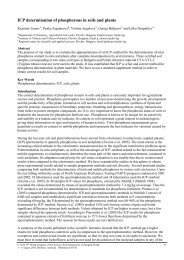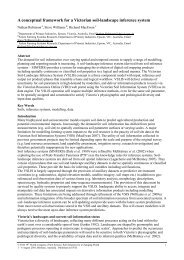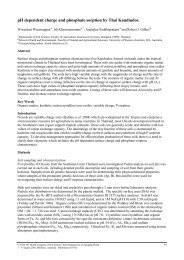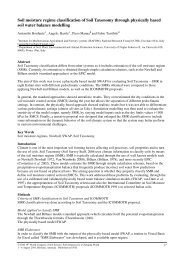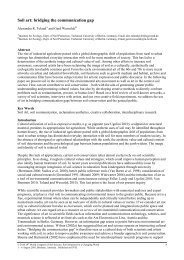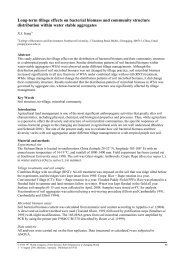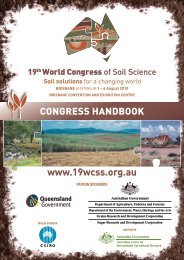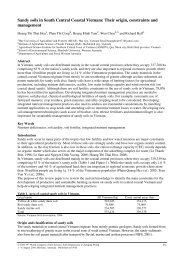Nguyen Quang Chon - International Union of Soil Sciences
Nguyen Quang Chon - International Union of Soil Sciences
Nguyen Quang Chon - International Union of Soil Sciences
You also want an ePaper? Increase the reach of your titles
YUMPU automatically turns print PDFs into web optimized ePapers that Google loves.
Effect <strong>of</strong> P and Si amendment on the charge characteristics and management <strong>of</strong><br />
a Geric soil<br />
<strong>Chon</strong> <strong>Quang</strong> <strong>Nguyen</strong> A , Chris Guppy A and Phil Moody B<br />
A School <strong>of</strong> Environmental and Rural Science, University <strong>of</strong> New England, Armidale, NSW, 2351, Australia.<br />
B Department <strong>of</strong> Environment and Resource Management, Indooroopilly, Qld. 4068, Australia.<br />
C Corresponding author. Email qnguyen7@une.edu.au<br />
Abstract<br />
Improving surface charge characteristics <strong>of</strong> geric Ferralsols may increase nutrient retention in highly<br />
weathered tropical soils <strong>of</strong> Vietnam. Application <strong>of</strong> increasing amounts <strong>of</strong> fused magnesium phosphate<br />
(FMP) increased soil pH by one unit and cation exchange capacity (CEC) 10-fold following 7 days<br />
incubation near field capacity at 40 o C. Similarly, calcium and magnesium silicate amendments at rates<br />
designed to apply the same amount <strong>of</strong> silicon as a high FMP application also increased pH and CEC. In<br />
contrast pH 0 remained relatively unchanged except following high silicon application. It is recommended<br />
that strategies that increase pH are more likely to increase CEC in geric soils than amendments that aim to<br />
lower the pH 0 .<br />
Key Words<br />
<strong>Soil</strong> charge, geric property, pH 0 , CEC, silicate, fused magnesium phosphate, phosphorus buffer index, charge<br />
fingerprint.<br />
Introduction<br />
In Vietnam, upland soils such as Acrisols and Ferralsols cover about 72 percent <strong>of</strong> the total surface (<strong>Nguyen</strong><br />
and Thai 1999; Ton et al. 1996). These highly weathered tropical soils are characterised by high desilication,<br />
soil acidity and phosphorus fixation and are intensively cultivated with minimal fertiliser input(<strong>Nguyen</strong> and<br />
Thai (1999). <strong>Soil</strong> surface charge is <strong>of</strong>ten characterized by net positive charge, a geric property, especially in<br />
the subsoil layer <strong>of</strong> Ferralsols (Moody and Phan 2008), where the soil pH in water is close to or lower than<br />
that in 1 M KCl (Phan et al. 2005). Therefore, cations are easily leached and soil fertility conditions<br />
deteriorate. Theoretically, cation loss can be prevented by developing negative surface charge and thus<br />
creating additional cation exchange capacity (CEC) (Uehara and Gillman 1981). This can be obtained either<br />
by raising soil pH, increasing the electrolyte concentration in the soil solution or lowering the pH 0 . <strong>Soil</strong><br />
amendments that may affect these soil properties include lime, phosphate, silicate and organic matter<br />
application. This paper presents the effect <strong>of</strong> P and Si amendment application on the charge characteristics <strong>of</strong><br />
a Ferralsol from north Queensland having similar charge characteristics to Ferralsols in the uplands <strong>of</strong><br />
Vietnam.<br />
Materials and methods<br />
<strong>Soil</strong> collection<br />
<strong>Soil</strong> was collected at a depth <strong>of</strong> 20-40cm (to remove interference from organic matter in determining charge<br />
characteristics) from a Pingin series Red Ferrosol under sugarcane cultivation in north Queensland This soil<br />
has similar geric properties to many upland soils in Vietnam. The sample was air-dried and passed through a<br />
2mm-sieve before taking a representative sample for incubation and analysis. <strong>Soil</strong> properties and soil charge<br />
characteristics are presented in Table 1.<br />
<strong>Soil</strong> incubation and analysis<br />
A 100 g soil sample with 20% moisture content, i.e. 100 g soil + 20 mL water, was incubated in a pot placed<br />
in the oven at 40 0 C. Water was added daily to replace evaporative losses and to maintain moisture content at<br />
20%. Eight treatments were involved in this study. Fused magnesium phosphate (FMP) was applied at the<br />
rates <strong>of</strong> 0, 75, 150 and 300 mg P /kg. The silicate materials, wollastonite (Ca-Si) and olivine (Mg-Si) were<br />
added at rates equal to the Si content in FMP at 300 mg P /kg i.e. 320 mg Si /kg. Similarly, two other silicate<br />
materials, acidulated wollastonite (Ac-Ca-Si) and acidulated olivine (Ac-Mg-Si), were added to be<br />
equivalent in applied Si to that <strong>of</strong> the 150 mg P /kg application <strong>of</strong> FMP, i.e. 160 mg Si /kg. Chemical<br />
components <strong>of</strong> amendments are presented in Table 2.<br />
© 2010 19 th World Congress <strong>of</strong> <strong>Soil</strong> Science, <strong>Soil</strong> Solutions for a Changing World 56<br />
1 – 6 August 2010, Brisbane, Australia. Published on DVD.
Table 1. <strong>Soil</strong> and soil charge properties <strong>of</strong> a Pingin subsoil (20-40cm).<br />
Si Si salt ext. A P sorbedB <strong>Soil</strong> pH C pH 0<br />
D<br />
CEC b<br />
E<br />
CEC t AEC F PZNC G<br />
(%) (µM) (mg/kg)<br />
(cmol c /kg)<br />
6.48 78 985 4.27 4.67 0.22 0.24 0.62 4.79<br />
A 0.01M CaCl 2 (1:1000 ratio <strong>of</strong> soil:solution); B P sorbed from added 1000 mg P /kg; C <strong>Soil</strong> pH in 0.002 M CaCl 2 (1:10<br />
ratio <strong>of</strong> soil:solution); D CEC b – Base cation exchange capacity; E CEC t – Total cation exchange capacity; F AEC – Anion<br />
exchange capacity; G PZNC – Point <strong>of</strong> zero net charge.<br />
Table 2. Chemical components <strong>of</strong> amendments.<br />
Amendments P<br />
(%)<br />
Si<br />
(%)<br />
Si salt extractable A<br />
(µM)<br />
Neutralising value<br />
(%)<br />
FMP 7.11 7.47 139 47.7<br />
Ca-Si - 25.65 167 48.1<br />
Ac-Ca-Si - 20.00 nd 0<br />
Mg-Si - 11.02 103 53.3<br />
Ac-Ca-Si - 7.23 525 0<br />
A0.01M CaCl 2 (1:1000 ratio <strong>of</strong> soil:solution).<br />
After seven days <strong>of</strong> incubation, soils were analysed for pH, pH 0 , basic cation exchange capacity (CEC b ), total<br />
cation exchange capacity (CEC t ), anion exchange capacity (AEC) and point <strong>of</strong> zero net charge (PZNC) by<br />
using the charge fingerprint procedure (Gillman 2007); Colwell extractable P (Colwell 1963) and phosphorus<br />
buffering index (PBI) (Burkitt et al. 2002) were also determined.<br />
Results<br />
After seven days <strong>of</strong> incubation at high temperature (40 o C), soil pH (in 0.002 M CaCl 2 , 1:10) increased with<br />
increasing levels <strong>of</strong> applied FMP, about one unit pH increment after treatment with 300 mg P /kg (Figure 1).<br />
FMP applications also shifted pH 0 and PZNC to lower values than that <strong>of</strong> the incubated control; the more P<br />
applied, the lower the values <strong>of</strong> pH 0 and PZNC. In comparison with the non-incubated baseline soil (Table 1),<br />
soil pH and pH 0 were higher in all incubated treatments, while PZNC was lower (Figure 1).<br />
pH & pHo<br />
6.0<br />
5.5<br />
5.0<br />
4.5<br />
4.0<br />
pH pHo CECb AEC<br />
1.0<br />
0.8<br />
0.6<br />
0.4<br />
0.2<br />
CEC b & AEC (cmol c kg -1 )<br />
0.0 3.5<br />
0.0<br />
0 75 150 300<br />
mg P kg -1 soil<br />
Figure 1. Change in soil pH and charge characteristics <strong>of</strong> a Pingin series subsoil as a function <strong>of</strong> P application as<br />
fused magnesium phosphate following incubation for 7 days at 40 o C near field capacity.<br />
Phosphorus affected both CEC and AEC <strong>of</strong> the soil, the higher P application, the greater the increase in CEC<br />
and AEC (Figure 1). However, the increase in AEC was smaller than CEC following application <strong>of</strong> 300 mg<br />
P /kg. Phosphorus availability measured by Colwell (1963) extraction increased linearly from 34 to 100 mg/kg<br />
with increasing P application as FMP. A corresponding decrease in PBI from 840 to 700 was also observed.<br />
Where Pingin soil was treated with unacidulated silicate amendments, soil pH increased and pH 0 decreased<br />
(Table 3). In contrast, PZNC was higher in silicate treated soils compared to the incubated control, except the<br />
soil with Ac-Mg-Si. CEC and AEC also increased with silicate applications, but AEC decreased in the Ac-<br />
Ca-Si treatment. Similar to the effects with P application, silicate addition resulted in higher pH 0 and lower<br />
PZNC than those <strong>of</strong> the non-incubated baseline soil, but CEC and AEC <strong>of</strong> the soil treated with silicates were<br />
reduced in comparison to the non-incubated initial values. The exception was the Ac-Mg-Si treatment where<br />
both CEC b and CEC t were kept at the same values as the non-incubated baseline soil (Table 1 and 3).<br />
© 2010 19 th World Congress <strong>of</strong> <strong>Soil</strong> Science, <strong>Soil</strong> Solutions for a Changing World 57<br />
1 – 6 August 2010, Brisbane, Australia. Published on DVD.
Table 3. Effect <strong>of</strong> Si application on the charge characteristics, P availability and PBI <strong>of</strong> a Pingin series subsoil<br />
incubated for 7 days at 40 o C near field capacity.<br />
Amendements Si added pH (CaCl2) pH 0 PZNC CEC b CEC t AEC Colwell P PBI<br />
(kg /ha) (1:10)<br />
(cmol c /kg)<br />
Control<br />
Ca-Si<br />
Ac-Ca-Si<br />
Mg-Si<br />
Ac-Mg-Si<br />
0<br />
420<br />
210<br />
420<br />
210<br />
4.49<br />
4.88<br />
4.54<br />
4.81<br />
4.61<br />
5.63<br />
5.41<br />
5.41<br />
5.43<br />
5.32<br />
4.28<br />
4.43<br />
4.35<br />
4.42<br />
4.14<br />
0.09<br />
0.19<br />
0.11<br />
0.17<br />
0.21<br />
0.11<br />
0.21<br />
0.14<br />
0.18<br />
0.23<br />
0.06<br />
0.10<br />
0.01<br />
0.11<br />
0.11<br />
33.5<br />
35.8<br />
33.1<br />
33.6<br />
31.5<br />
838<br />
798<br />
812<br />
816<br />
784<br />
Although Colwell P was not responsive to applied silicates, PBI decreased (Table 3). Hence soil P sorption<br />
capacity may be reduced by applying silicate.<br />
Discussion<br />
The application <strong>of</strong> FMP and raw silicate materials (Ca-Si and Mg-Si) increased soil pH accounting for the<br />
majority <strong>of</strong> change in soil CEC b (Figure 1, Table 3). Increased soil pH following application <strong>of</strong> phosphate or<br />
silicate ions to ferric soils is most likely associated with release <strong>of</strong> hydroxide ions following specific<br />
adsorption reactions (Smyth and Sanchez 1980). Hence the most effective way to increase charge in geric<br />
soils is to increase soil pH rather than adjust pH 0 .<br />
The exception to this trend occurred following application <strong>of</strong> acidulated Mg-Si where minimal change in pH<br />
was observed, yet CEC b more than doubled (Table 3). The majority <strong>of</strong> the change in CEC b for this<br />
amendment may be associated with lowering <strong>of</strong> the pH 0 . The pH 0 <strong>of</strong> treated soils shifted to lower values<br />
compared to the incubated control; this can be attributed to the specifically adsorbed anions HPO 4 2- and<br />
SiO 4 2- that are released from FMP and silicate amendments (Qafoku et al. 2004; Uehara and Gillman 1981;<br />
Zhang and Zhao 1997). However, the pH 0 <strong>of</strong> all incubated soils, including the control, were higher than the<br />
pH 0 value <strong>of</strong> the non-incubated baseline soil. A number <strong>of</strong> factors may be involved with shift in pH 0<br />
following incubation. First, the presence <strong>of</strong> Ca in the amended treatments may result in charge reversal due<br />
to Ca adsorption into the Stern layer (Uehara and Gillman 1981). Wann and Uehara (1978) observed similar<br />
results following Ca-Si amendments on Oxisols. Second, organic carbon coating Fe and Al oxides might<br />
have oxidised/mineralised during incubation at 40 o C, thus exposing surfaces with a relatively higher pH 0 .<br />
This explanation seems less likely because the test soil is a subsoil, but organic C analyses to compare<br />
incubated with non-incubated soils remain to be undertaken.<br />
The interesting result <strong>of</strong> this study is that only the pH 0 value <strong>of</strong> FMP applied at 300 mg P /kg was lower than<br />
soil pH. This might be caused by the dual effects <strong>of</strong> P and Si anions that were released from FMP fertiliser.<br />
The relationship between soil pH and pH 0 determines the magnitude <strong>of</strong> net charge; therefore, on one hand the<br />
CEC in this treatment was greatly increased, and on the other hand PZNC was greatly decreased compared to<br />
the other treatments. In addition, FMP application brought about an increase in Colwell P and reduced PBI <strong>of</strong><br />
the soil. This is a logical effect <strong>of</strong> the P content in FMP and also the competitive effect <strong>of</strong> Si content in FMP<br />
with P on the adsorptive sites.<br />
Among silicate sources, although Ac-Mg-Si did not increase soil pH as much as Ca-Si and Mg-Si, it was the<br />
most responsive amendment in terms <strong>of</strong> reducing pH 0 and increasing CEC b <strong>of</strong> the soil. Also, Ac-Mg-Si did<br />
not increase Colwell P, but it decreased PBI to the lowest value compared to the other silicate sources (Table 3).<br />
These effects can be explained by more available Si being released to the soil from this product than the others,<br />
as salt extractable Si <strong>of</strong> Ac-Mg-Si was much higher than that in the other silicate amendments (Table 2).<br />
Conclusion<br />
The Pingin series subsoil has similar charge characteristics to those <strong>of</strong> the geric Ferralsols <strong>of</strong> the uplands <strong>of</strong><br />
Vietnam in terms <strong>of</strong> very low CEC and high pH 0 . The application <strong>of</strong> FMP fertiliser not only overcomes a<br />
potential phosphorus deficiency, but through increasing pH may also increase soil charge and increase<br />
nutrient retention. Applying Ca-Si and Mg-Si materials can also rectify the problem <strong>of</strong> the geric property in<br />
highly weathered tropical soils by increasing the nutrient holding capacity <strong>of</strong> the soil and increasing P<br />
availability to the plant by the adsorptive competition <strong>of</strong> Si with P for sorption sites.<br />
© 2010 19 th World Congress <strong>of</strong> <strong>Soil</strong> Science, <strong>Soil</strong> Solutions for a Changing World 58<br />
1 – 6 August 2010, Brisbane, Australia. Published on DVD.
Acknowledgement<br />
This study is a part <strong>of</strong> PhD program funded by the Australian Centre for <strong>International</strong> Agricultural Research<br />
(ACIAR) through a John Allwright Fellowship, and is being undertaken at the Department <strong>of</strong> Agronomy and<br />
<strong>Soil</strong> Science <strong>of</strong> the University <strong>of</strong> New England. The authors gratefully acknowledge the considerable<br />
technical input <strong>of</strong> Leanne Lisle.<br />
References<br />
Burkitt LL, Moody PW, Gourley CJP, Hannah MC (2002) A simple phosphorus buffering index for<br />
Australian soils. Australian Journal <strong>of</strong> <strong>Soil</strong> Research 40, 497-513.<br />
Colwell JD (1963) The estimation <strong>of</strong> phosphorus fertiliser requirements <strong>of</strong> wheat in southern New South<br />
Wales by soil analysis. Australian Journal <strong>of</strong> Experimental Agriculture and Animal Husbandry 3, 190-<br />
197.<br />
Gillman GP 2007 An analytical tool for understanding the properties and behaviour <strong>of</strong> variable charge soils.<br />
Australian Journal <strong>of</strong> <strong>Soil</strong> Research 45, 83-90.<br />
Moody PW, Phan TC (2008) '<strong>Soil</strong> Constraints and Management Package (SCAMP): Guidelines for<br />
Sustainable Management <strong>of</strong> Tropical Upland <strong>Soil</strong>s'. (Australian Centre for <strong>International</strong> Agricultural<br />
Research: Canberra).<br />
<strong>Nguyen</strong> TS, Thai P (1999) 'Upland <strong>Soil</strong>s in VIETNAM, Degradation and Rehabilitation'. Agricultural<br />
(Publishing House: Hanoi) (in Vietnamese)<br />
Phan TC, Cong DS, <strong>Nguyen</strong> QC, <strong>Nguyen</strong> BD (2005) 'Replenishing the Phosphorus Capital in Depleted <strong>Soil</strong>s<br />
<strong>of</strong> the Central Highlands and the Eastern Region <strong>of</strong> South Vietnam'. Project ET-2000/PRV (VLIR) - 05,<br />
Hochiminh city (in Vietnamese)<br />
Qafoku NP, Ranst EV, Noble A, Baert G (2004) Variable charge soils: Their mineralogy, chemistry and<br />
management. 'Advances in Agronomy' 84,159-215.<br />
Smyth TJ, Sanchez PA (1980) Effects <strong>of</strong> lime, silicate, and phosphorus applications to an Oxisol on<br />
phosphorus sorption and ion retention. <strong>Soil</strong> Science Society <strong>of</strong> America Journal 44, 500-505.<br />
Ton TC, Tran KT, <strong>Nguyen</strong> TD, <strong>Nguyen</strong> TS, Le TB (1996) '<strong>Soil</strong>s in Vietnam'. (Agricultural Publishing<br />
House: Hanoi) (in Vietnamese)<br />
Uehara G, Gillman GP (1981) 'The Mineralogy, Chemistry, and Physics <strong>of</strong> Tropical <strong>Soil</strong>s with Variable<br />
Charge Clays'. (Westview Press, Inc.: Boulder, Colorado).<br />
Wann SS, Uehara G (1978) Surface manipulation in constant surface potential soil colloids: I. Relation to<br />
sorbed phosphorus. <strong>Soil</strong> Science Society <strong>of</strong> America Journal 42, 565-570.<br />
Zhang XN, Zhao AZ (1997) Surface Charge. In 'Chemistry <strong>of</strong> variable charge soils'. (Ed TR Yu) pp. 17-63.<br />
(Oxford University Press: New York).<br />
© 2010 19 th World Congress <strong>of</strong> <strong>Soil</strong> Science, <strong>Soil</strong> Solutions for a Changing World 59<br />
1 – 6 August 2010, Brisbane, Australia. Published on DVD.



